Smoking brisket is such a satisfying thing to do, but definitely takes time. Wrapping it, if done right, can significantly shorten the smoking time with excellent results. If you’re wondering when to wrap brisket, you’re in the right place!
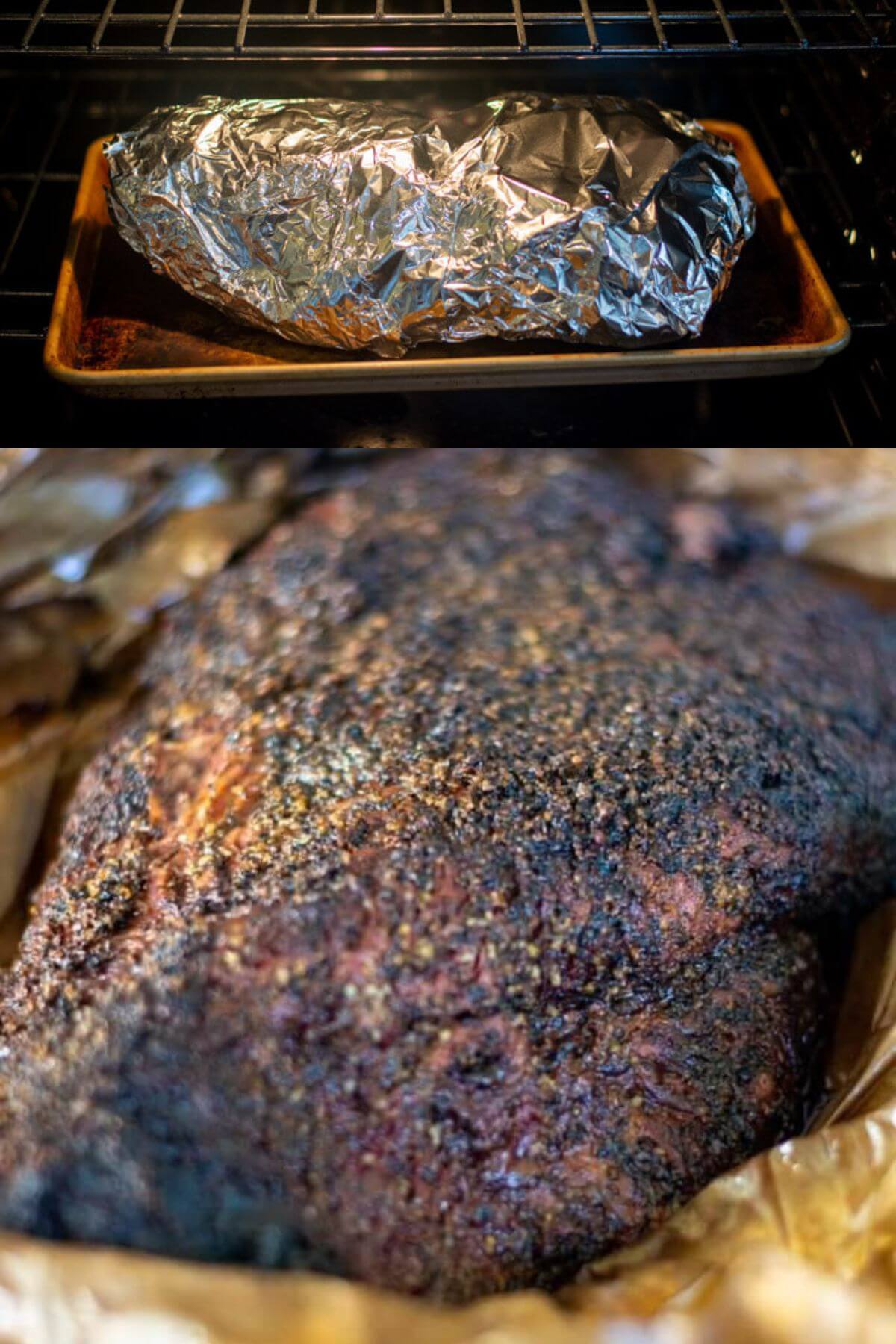
Smoking a brisket takes time, effort, and a lot of patience. If you’re not a seasoned cook, you’ll probably get overwhelmed with all the suggested tips that other cooks claim will make your meat taste heavenly.
Many pit masters agree that wrapping brisket is the way to go. So, if you want to know when to wrap brisket and why it improves the way your meat cooks and tastes, keep reading.
Why Should You Wrap Brisket?

Cooking is an individual experience, and what works for others might not work for you. Wrapping your brisket isn’t a must, but it’s highly recommended, and some pit masters swear on its results.
Here are the major benefits of wrapping your brisket while it’s smoking.
Reduce the Cooking Time
Slow cooking is the way to go if you want to enjoy juicy and tasty meat.
One pound of meat takes between 30 and 60 minutes to smoke to perfection, so a 20-pound piece of brisket can take between 10 and 20 hours to smoke.
If you’re preparing brisket for a family dinner and you feel that you’re running out of time, wrapping it will help reduce the cooking time.
By wrapping the meat, you trap the moisture inside, maintaining the brisket’s internal temperature. It insulates the meat, so the internal temperature stays high to cook your brisket faster.
Enjoy Juicy Meat
The perfect smoked brisket is tender, moist, and juicy. However, cooking for extended periods risks drying out the meat.
This is one of the biggest challenges you’ll face as a beginner cook. You’re risking ending up with undercooked meat or dry meat that you’ve cooked for too long and feels chewy.
Wrapping your brisket keeps the moisture in the meat by locking in the natural juices.
Not only will it make your meat juicer and more tender, but it will also make your brisket more flavorful.
Control The Crust
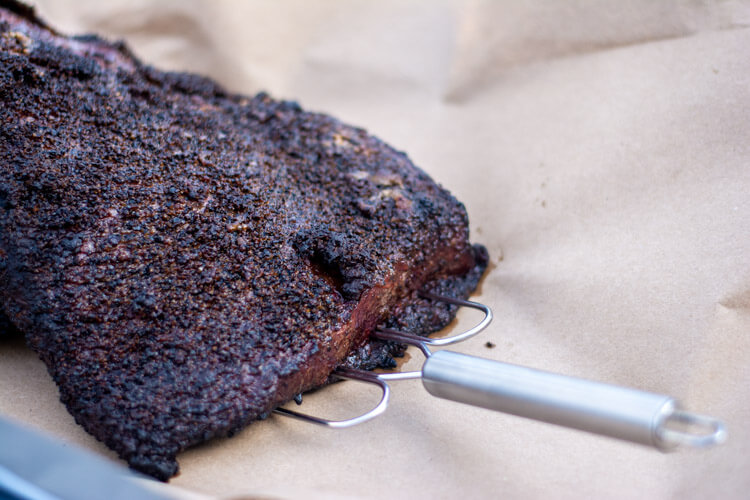
Even a seasoned cook might not be able to control how the outer layer or bark looks. As you smoke the meat until the internal meat is perfectly cooked, the outer layer might cook too much, becoming too crusty or too dark.
This can happen because of the stall, a phenomenon that causes the internal temperature of large cuts of meat to hit a plateau, which can last several hours. During this time, the meat can lose too much moisture, while the bark overcooks.
A stall is common with large cuts of meat. As you increase the temperature, the meat cooks perfectly until the temperature hits 160 to 165°F, and the meat stops cooking for a while.
If you stop cooking your brisket, then it will be undercooked, and if you do nothing and wait, it might extend the cooking times too much. Wrapping your brisket is one of the easiest ways to overcome this problem.
Due to the increasing temperature, the meat starts to sweat, and the moisture rises to the surface and then evaporates. Even if you increase the smoker temperature, the meat’s temperature will continue to plateau for a while, bringing your meat to a stall.
Wrapping the meat prevents contact with air that allows the moisture to evaporate. Wrapping it in butcher paper or foil will beat the stall in no time flat.
Control Smoke Flavor
Smoking meat adds a tasty flavor, but too much smoke is not for everyone.
If you prefer a milder smoke flavor, consider wrapping your meat in the 150-170°F range, once you are happy with the outer bark.
When to Wrap Brisket
Wrapping brisket is a method known as the Texas Crutch. It refers to wrapping the meat in aluminum foil or butcher paper.
Although this is a technique that professional pit masters use, you can also practice it at home.
Most cooks get confused about the right time to wrap your brisket. There are two factors to consider.
The first one is the internal temperature of the meat. Since the stall occurs between 150 and 170°F this is the approximate internal temperature range when you should wrap.
If you wrap your meat too early, you risk losing the bark, which adds a heavenly flavor. On the other hand, wrapping the meat too late might leave you with a chewy piece of overcooked meat. Blech!!
This is when the second factor comes into place. Once your brisket is in the stall temperature range, you will need to keep an eye on the outer crust.
Wrap the meat only when the bark is to your liking.
It’s worth noting that you will get the bark you had before wrapping. So if you wrap too soon, your brisket may have more of a steak flavor rather than the smokiness it should have.
Some people choose to wrap the brisket right from the beginning to reduce the cooking time significantly. This is a safe practice if you’re less experienced and want to have your brisket done fast for dinner. However, if you do this, you’ll have a piece of brisket that lacks the tasty smoky flavor and the dark bark color.
We recommend you wait until the meat hits the stall. This usually happens eight to ten hours into the smoke, and then wrapping it before putting it back on the grill or smoker to continue cooking.
What Is The Best Way To Wrap Brisket?
Aluminum foil is the popular option. It retains internal heat and moisture and virtually guarantees that your brisket will taste and look delicious. However, some seasoned pit masters prefer butcher paper over aluminum foil.
Butcher paper is FDA approved for wrapping and touching food, so it’s perfectly safe to use.
The main purpose of butcher paper is to prevent leaking and preventing the moisture from escaping, so you won’t end up with a dry meat.
Unlike parchment paper, butcher paper is thick and tolerates longer cooking times, which is you’ll need if you’re cooking brisket.
It’s sturdy enough to withstand high temperatures, up to 420°F, so it won’t burn or stick to your meat.
If you’re using butcher paper, you can wait a little longer until the internal temperature of your meat reaches 170 to 180°F.
Unlike aluminum foil, which isn’t permeable, butcher paper allows the meat to breathe, so your bark doesn’t turn soggy.
What Are The Options For Wrapping?
Cooking is all about experimenting and trying new things. If one thing doesn’t work, you can try another method until you find one that really works for you.
There are several factors that affect the taste of meat, including the duration and temperature used for cooking it. As a result, you have different options to consider when you’re choosing the best wrapping technique for your meat.
Naked
Wrapping your meat is highly recommended, but it’s not always necessary. If you don’t mind taking more time to cook your brisket, then keep it unwrapped.
To avoid over-drying the meat, keep an eye on it and regularly check the internal temperature. There are a few things you can do to prevent your brisket from drying if you choose the naked method.
The first one is to make sure that you’ve picked the right cut. Having enough marbling or fat will keep the meat moist while cooking it for extended periods.
Always cook the meat with the fatty side up because when the fat melts, it dribbles over the meat to give it a nice crust and keep it tender and juicy.
If you’re using a smoker or grill, add a water pan to increase the humidity.
Use a dry rub. It doesn’t just enhance the flavors, but it also create a moisture-sealing crust that prevents your meat from getting too dry.
You should always start with a higher temperature to create this crust before lowering it to ensure the meat is cooked to perfection from the inside.
Pros
- No extra tools are needed
- Smokier taste
- Crispier bark and more intense color
Cons
- The meat will hit the stall point mid-way while cooking
- It takes more time to cook to perfection
Aluminum Foil
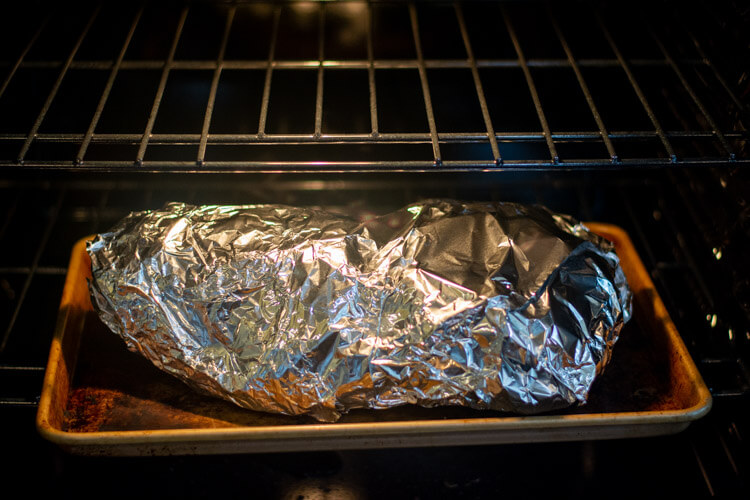
Using aluminum foil is one of the easiest ways to wrap your brisket.
It’s readily available in your kitchen, sturdy enough to withstand heat, and won’t let the moisture escape.
We also use it combined with butcher paper to smoke brisket and it always turns out delicious! Once we wrap the brisket, we finished in the oven just to show how flexible this technique is.
You can either wrap the met tightly with the foil or keep it a bit loose.
Tight wrapped foil may cause the bark to become a bit mushy, and unless you later unwrap it to finish on the grill, you may be left with an undesirable texture on the outside.
Keeping the foil loose is also called ‘While this works for us, you can try the ‘boating.’ Simply create a boat using your aluminum foil and add some liquid to increase the level of moisture in your meat.
Then, wrap it with another piece of aluminum foil. This works better than completely wrapping the brisket in aluminum foil.
For a crispier, smokier outer crust, remove the foil once the stall is over to prevent excess moisture buildup.
Pros
- Easy to master
- Aluminum foil is readily available at home
- Fastest cooking time
Cons
- The meat loses some of its smokiness
- Bark can become too moist and even soggy
Butcher Paper
Butcher paper seems delicate, but it actually works perfectly. It’s heat-resistant and moisture-resistant, and it will tolerate extended cooking times.
Using butcher paper to wrap your brisket is excellent if you’re chasing a more intense smoky flavor.
Nevertheless, you need to make sure that you’re picking the right type for this process.
Butcher paper is breathable, unlike aluminum foil, so it retains the internal heat and moisture without causing your bark to become too mushy.
Since there are different types of butcher paper on the market, you need to pick the right one for the job.
White butcher paper is suitable for wrapping meat for storage purposes but doesn’t trap moisture. I don’t recommend using this for smoking.
Pink or peach butcher paper is a much better option for wrapping. It’s sturdy enough to prevent leaks of any liquid, and allows the meat to breathe to prevent sogginess that ruins the crust.
Unlike aluminum foil which completely seals your brisket, butcher paper allows some extra smoke to pass through.
You’ll need to use two pieces of butcher paper, making sure that each one is at least four times longer than the piece of meat.
Place the two sheets on top of each other, so one overlaps the other by half of its width.
Add the brisket and start folding the pieces of paper, tucking the sides under the meat. You can get away with wrapping the butcher paper tightly because it’s breathable.
Pros
- Allows more smoke to get into the meat
- Reduced cooking time
- Most tender texture
- Retains the bark’s crunchiness
Cons
- Requires time and practice to master the wrapping technique
Disadvantages Of Wrapping
Wrapping the meat the right way minimizes the risk of ruining your brisket. Even with the best technique and materials, wrapping brisket has some disadvantages.
A trade-off is to be expected, so here are some cons of wrapping.
Loss Of Smoky Flavor
This is probably the most important disadvantage because when you wrap the meat, it creates a barrier between its surface and the smoke. However, using pink butcher paper can slightly help.
Since it’s porous, it will allow some smoke to get into the meat while it’s cooking. The smoke flavors the meat during the first few hours of cooking it, and the butcher paper prevents it from escaping.
Moreover, the benefits of faster cooking time and better bark outweigh this disadvantage.
Loss Of Texture
Nothing beats the crunchy bark, while the meat feels juicy and tender. Wrapping the meat traps a layer of moisture around the meat while speeding up the cooking process.
This excess moisture causes the bark to become softer. If you keep the brisket wrapped for too long, the bark can become too soggy.
You can unwrap it once it gets past the stall, and the internal temperature starts rising again.
Then, continue smoking the brisket unwrapped, until the meat reaches the desired temperature to overcome this issue. This will help restore the crunchiness and crispiness of the bark.
Most experienced cooks agree the ideal brisket internal temperature is around 200-205°F.
Overcooking
Wrapping the brisket increases the internal temperature to accelerate the process of cooking. However, it’s hard to control how rapidly the internal temperature will rise.
There are several factors that control how fast the internal temperature will rise. These include the meat itself, the quality and sturdiness of the butcher paper, the humidity level inside the smoker, how tightly you wrap the paper, and the temperature of the smoker.
Following a timed recipe might not work or won’t yield the results you expect if any of those variables work to your disadvantage. Instead, you should rely on the internal temperature to assess how cooked your brisket is.
The key is to use a meat thermometer and remove the wrap once the meat’s internal temperature goes over 170°F.
I recommend investing in a wireless meat thermometer as it will let you effortlessly monitor the internal temperature of whatever meat you’re smoking or grilling.
Also, raising the hood of your smoker too often allows some of the heat to escape, lengthening the total cooking time. If you have a wireless thermometer, visually inspecting the brisket much less often.
After this, cook the brisket until its internal temperature reaches 200-205°F. During this time, the bark will re-crisp and the brisket’s color will become more intense.
The temperature will drop once you remove the wrap, but this won’t ruin your meat because it has already been cooked.
Tips and Tricks
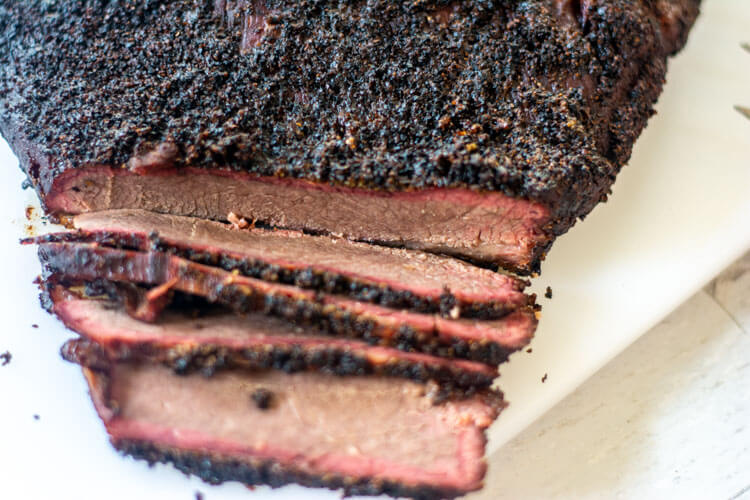
Whether you choose to wrap your meat or leave it naked, nothing will improve its texture more than letting it rest once the cooking is over. Leaving the meat to rest improves its tenderness and moisture, so it feels like it’s melting in your mouth while having a crunchy and crispy bark.
The internal temperature of the meat drops and the internal juices get infused within the meat.
Cutting it right after removing it from the smoker or grill will lead to a loss of about ten tablespoons of liquid.
This amount of liquid loss decreases by almost 50% when you wait for a few minutes before slicing.
The recommended resting time is 30 to 60 minutes or even longer, for large meat cuts such as brisket.
Follow these tips while letting your brisket rest for the best results.
Wrap Up
Whether or not you choose to wrap your brisket, as long as you follow the proper steps, it will turn out delicious!
This is a large cut of meat and it’s totally normal if you end up with leftovers. The good news is brisket reheats well so it’s worth saving for later use.
There are so many brisket leftover recipes and sides that go well with brisket, there’s no excuse for letting it go to waste.
After all, brisket is one of the best meats to smoke, and if you go to the trouble of making it, you might as well enjoy it to the last bite.
Related Articles

Ginny Collins is a passionate foodie and recipe creator of Savor and Savvy and Kitchenlaughter. Indoors she focuses on easy, quick recipes for busy families and kitchen basics. Outdoors, she focuses on backyard grilling and smoking to bring family and friends together. She is a lifelong learner who is always taking cooking classes on her travels overseas and stateside. Her work has been featured on MSN, Parade, Fox News, Yahoo, Cosmopolitan, Elle, and many local news outlets. She lives in Florida where you will find her outside on the water in her kayak, riding her bike on trails, and planning her next overseas adventure.
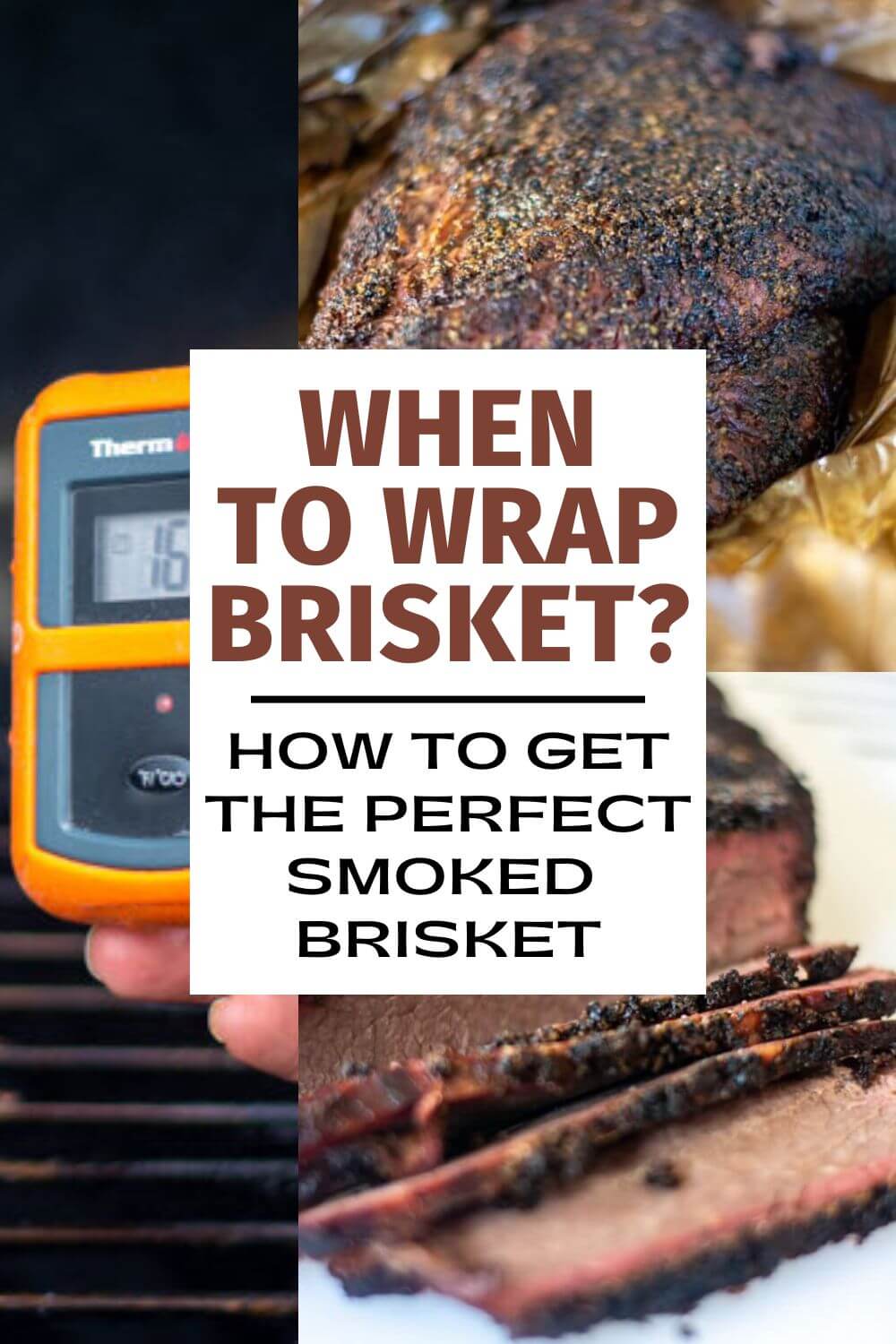




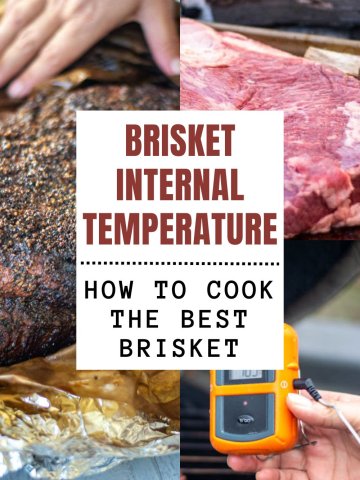
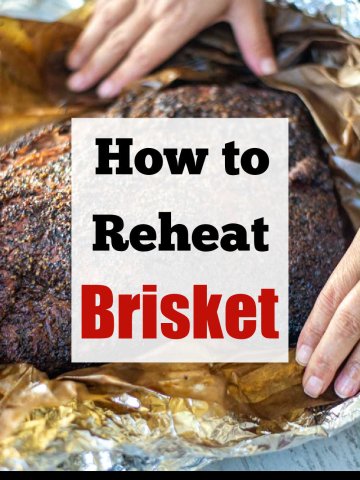
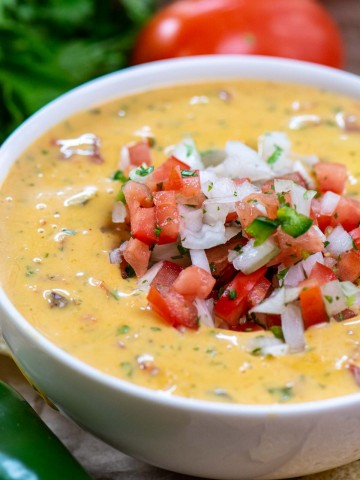
Leave a Reply